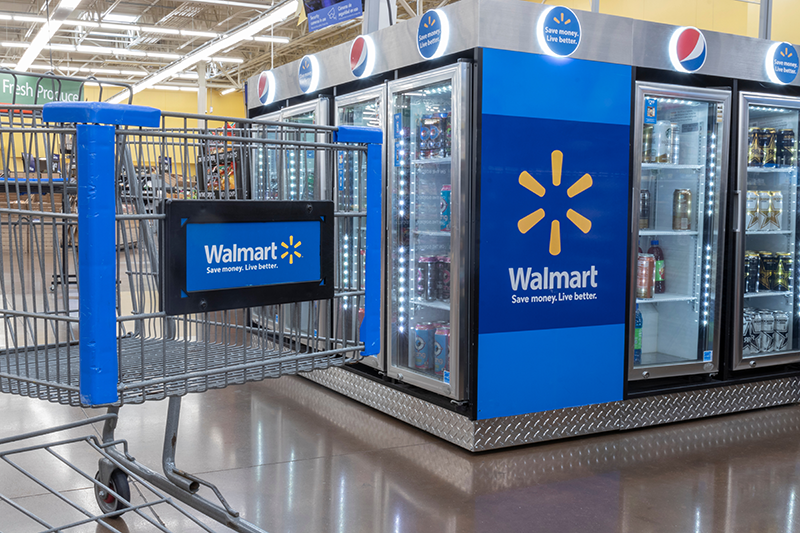Walmart and RFID: The Relationship That put RFID on the Map
Article updated 04/08/2024

How Walmart Uses RFID
Recently announced, Walmart's RFID mandate is a requirement for all suppliers to apply RFID labels to all incoming products. This new RFID initiative will give the retail giant more control over inventory in the store, and ultimately, provide a better customer experience; however, this isn't Walmart's first foray into RFID.
How Walmart Put RFID on the Map
If there’s any one company to thank for increasing RFID’s public awareness, it’s Walmart.
In 2003, the general public had little to no knowledge of RFID technology. However, this quickly changed when the retail chain announced that their top 100 suppliers would be required to attach RFID tags to all cases and pallets of incoming shipments. The previous year, Walmart launched its RFID-based inventory tracking pilot with only 7 stores in Texas and 8 product suppliers participating.
In addition to shipments, electronics like television sets, CDs, and stereos were also individually tagged due to their high-value. Walmart sought to gradually increase the number of stores involved, aiming to have RFID technology implemented company-wide by the end of 2006.
Decision-makers at Walmart believed that the company was lacking in sales and customer satisfaction due to inaccurate stock numbers. They hoped that enhanced supply chain visibility and more accurate ordering decisions made possible by RFID could resolve these issues.
As a reaction to Walmart’s announcement, many other big-name retailers began experimenting with and/or adopting RFID, including Best Buy, Target, and Home Depot, and European chains Tesco and Metro Stores. (1)
A Rocky Start
Though it was evident that Walmart’s RFID initiative was valuable, the infancy of RFID technology led to some initial problems. For instance:
1. RFID Tag Purchasing - Because the system was a new process for both the product suppliers and Walmart, it was unclear who was responsible for purchasing tags, which was a huge obstacle.
It is now understood that, whether the supplier or the retailer purchases RFID tags, the tagging cost will be included in the overall price of the items once they hit the shelves.
2. Acceptable Read Rates - Some Walmart locations struggled to achieve acceptable read rates with significant portions of tags unable to be read. Many of these issues were due to cases containing or being composed of materials that interfere with RF waves, like metals and liquids.
Today, this problem can be solved with special-made tags and other mitigation techniques. These options include incorporating RFID tags made specifically for use with water or metal or adding Radio Frequency (RF) absorbing materials.
RFID systems today often achieve average read rates of 98-100% accuracy. This number can vary slightly depending on the type of RFID system being used, what type of item is being tagged, and how the tagged items are stacked.
3. Ineffective Adhesives - Some tags had ineffective adhesives, causing them to detach from pallets of shipments and to even be unreadable.
The adhesives used on RFID tags are now much more resilient. Many RFID tags can also now be customized with industrial-strength adhesive, or adhesives that can withstand certain environmental factors such as heat or water.
4. Tag Cost – Tags used to track Walmart’s shipments weren’t as cost-effective as today. While tags currently average at $0.08-0.15 each, the average price in the early 2000s was $0.50-0.75. Since RFID was not widely used at this time, the technology generally cost more to make and implement.
Ironically, it was the wide-spread adoption of RFID systems by large retailers, such as Walmart, Target, and Tesco, that helped to make the technology more widely used and, therefore, less expensive to manufacture. This decrease in price is also a result of the technology’s development over the years resulting in smaller, more-efficient RFID tags.
Walmart’s use of RFID was ultimately received by critics and the public with mixed reviews. Many thought RFID offered value and still had a role in the future of shipment tracking but had yet to fully mature.
Walmart's RFID Success
A study conducted by the University of Arkansas RFID Research Center (now the Auburn RFID Lab) on Walmart’s use of RFID revealed that stores that incorporated RFID reduced out-of stocks at store level by 16% over non-RFID locations.
Regardless of these findings, some large retailers were still not inclined to adopt RFID due to the issues that occurred during Walmart’s adoption initiative. RFID continued to be used by Walmart and many other retailers, though in 2005 the technology didn’t have the retail boom expected. Instead, RFID found other niches in timing races, tracking hospital equipment, and inventory control.
Despite critics, by 2010 RFID technology had evolved enough that Walmart was tracking shipments to stores as well as goods within stores company-wide. The same year, Walmart announced that they would also use RFID tags to track certain sales floor items, starting with men’s jeans and underwear. Taking note of the success of this application, Bloomingdales, Macy’s, and several other major retailers began using RFID to track clothing.
To this day, all US Walmart locations use RFID to track incoming shipments and merchandise on the sales floor.
Where Can RFID and Retail Go from Here?
Due to the increase in online shopping, many stores fear the “retail apocalypse,” or losing in-person business to online retailers. However, this problem can be potentially mitigated with RFID technology.
![]()
Here are some ways that RFID continues to revolutionize operations for Walmart and other major retailers:
Walmart
- Inventory Visibility: By managing inventory with RFID, companies like Walmart can make shopping with a physical retailer more efficient. One way Walmart does this is by digitizing inventory information. With accurate stock information available online, customers can see what items are currently in stock at each store and can also order out-of-stock items.
- Customer Convenience: Walmart also offers a grocery pick-up system where customers can purchase goods online and then retrieve them from the store when they are ready. Some locations also offer grocery delivery. Without the use of RFID to track the quantity and location of in-store goods, this grocery system would likely be costly and inefficient.
2024 Walmart RFID Mandate Product Categories:
- Apparel
- Automotive
- Books
- Camera & Supplies
- Crafts
- Electronics
- Hardware
- Home Goods
- Lawn & Garden
- Media & Gaming
- Paint
- Sporting Goods
- Stationery
- Toys
Other Retailers Using RFID Technology
- Neiman Marcus
- Rebecca Minkoff
- Nike
- H&M
- LuluLemon
- Amazon
- Dick's Sporting Goods
- Macy's
- Uniqlo
- Allbirds
- Pacsun
- Target
Conclusion
Throughout the history of Walmart and RFID’s partnership, the two have helped each other to evolve and grow. RFID technology is now more advanced overall, and the average price per tag is now cost-effective. Due to these advancements, it is now easier for tags to be used in large quantities to identify shipments and the location of products on the sales floor.
If you would like to learn more about all things RFID, check out our website, our YouTube channel, comment below or contact us.
To learn more about industries using RFID, check out the links below!
Citation
(1) Clampitt, Harold G., MBA, PE. The RFID Certification Textbook, 3rd Edition. Copyright 2007.


